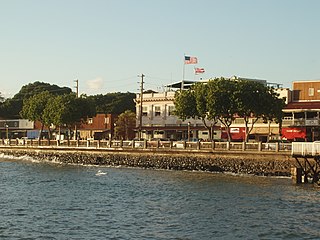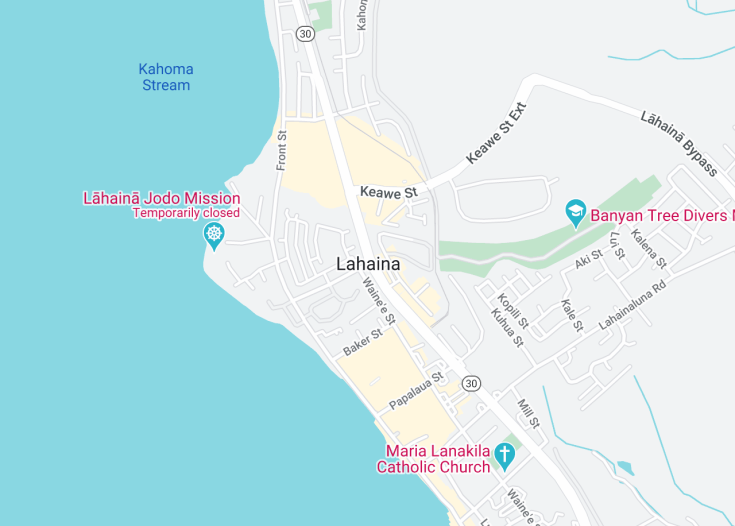Lahaina, located on the western coast of Maui in Hawaii, captivates visitors with its rich history and vibrant cultural tapestry. Historically a royal retreat and once the capital of the Hawaiian Kingdom, today it is admired for its scenic seaside views, historic landmarks like the Lahaina Historic District and the famous Banyan Tree Park which houses one of the largest banyan trees in the United States. The town is also renowned for its art galleries, restaurants, and lively Front Street, making it a perfect blend of historic relevance and contemporary appeal.
For an unforgettable experience, plan to visit during the annual Halloween celebration, often referred to as the “Mardi Gras of the Pacific.”
Spend a day exploring the Lahaina Historic Trail to immerse yourself in the area’s unique past and picturesque settings.
Top things to do & see in Lahaina
Select the following sights and activities to discover best tickets and tours available in Lahaina.
Lahaina: The Crown Jewel of Maui
| Country | Hawaii (USA) |
| Time in Lahaina | GMT-10 |
| Language spoken | English |
| Population | 11,704 (as of 2010 Census) |
| Currency | US Dollar (USD $) |
| Airports |
|
Lahaina, a historic town nestled on the picturesque western coast of Maui, Hawaii, boasts a rich tapestry of cultures and traditions. Once known as Lele, it was considered the royal capital of the Hawaiian Kingdom in the early 19th century. Today, Lahaina is renowned for its vibrant cultural scene, stunningly preserved historic sites, and thriving arts community. The town’s significance stems from its deep-rooted connection to Native Hawaiian history and its pivotal role during the whaling boom of the 19th century. Lahaina’s Front Street, named one of the “Top Ten Greatest Streets” by the American Planning Association, is a bustling promenade that hosts a variety of shops, restaurants, and galleries, and is a perfect example of the fusion of culture and commerce that makes the town unique.
Where is Lahaina?
Lahaina is situated on the northwestern coast of Maui, part of the Hawaiian archipelago in the central Pacific.
Distances:
| Route | Distance by car | Time by car |
|---|---|---|
| From Kahului to Lahaina | 36 miles | 55 minutes |
| From Kihei to Lahaina | 28 miles | 45 minutes |
What is Lahaina famous for?
Lahaina is famous for its historical significance as a former capital of the Hawaiian Kingdom and a popular whaling port. Its picturesque waterfront and vibrant arts scene also draw thousands of visitors each year.
History
Pre-European Contact (Before 1778)
Lahaina, located on the west coast of Maui, harbors a rich history beginning well before European contact. Originally known as Lele, this area was a significant royal center and the capital of the Kingdom of Hawaiʻi; many Aliʻi (Hawaiian royalty) chose it as their seat of power. The abundance of fresh water, fertile lands, and good fishing spots made Lahaina a highly desirable location for early native Hawaiian settlements.
The Monarchy Era (1795-1893)
King Kamehameha I, in his quest to unify the Hawaiian Islands, captured Lahaina in 1795, making it the capital of the unified Hawaiian Kingdom in 1820. This period saw Lahaina play a pivotal role in Hawaiian politics and culture. The kingdom’s first Christian church, the Wainee Church (now Waiola Church), was established here in 1823. Lahaina continued to flourish under the monarchy as its whaling industry and sugarcane plantations boomed.
Whaling Boom (1820s-1860s)
Lahaina became the Pacific’s whaling capital in the mid-19th century. With its natural harbor, it was a prime port for American, European, and other international whaling ships. At its peak, hundreds of ships visited yearly, drastically influencing local business and culture. This period brought significant changes, including the introduction of Western ideas and conflicts over whaling rights and regulations.
Annexation and Territory Status (1893-1959)
The overthrow of the Hawaiian Kingdom in 1893 marked the beginning of a new era. Lahaina, like the rest of Hawaii, was annexed by the United States in 1898, becoming a U.S. territory in 1900. This transition altered its economic and social structures significantly. The focus shifted from royal governance to territorial management, impacting local industries and the native population’s way of life.
Modern Lahaina (1959 to Present)
Since Hawaii became the 50th U.S. state in 1959, Lahaina has transformed into a major tourist destination known worldwide. Modern developments have embraced its rich historical heritage, making it a unique blend of past and present. Today, Lahaina’s economy is primarily driven by tourism, with numerous historical sites, shops, restaurants, and art galleries attracting visitors globally.
Visit Lahaina
Attractions and Activities in Lahaina
Exploring Lahaina offers a captivating blend of history, culture, and natural beauty. Key attractions include:
- Front Street: Named one of the “Top Ten Greatest Streets” by the American Planning Association, Front Street is the heart of Lahaina, lined with historic buildings, shops, restaurants, and galleries.
- Lahaina Historic Trail: A self-guided walking tour that covers 62 historic sites, including the famous Lahaina Banyan Tree, one of the largest in the US.
- Whalers Village Museum: Provides insight into Lahaina’s whaling era with artifacts and exhibitions.
- Ka’anapali Beach: Known for its white sandy beaches and clear waters, ideal for snorkeling, swimming, and sunset views.
Lahaina is also a gateway to the popular Humpback Whale National Marine Sanctuary, where visitors can go whale watching during the winter months.
Cultural Events in Lahaina
Lahaina hosts various cultural and historical events throughout the year, celebrating its rich heritage. Notable events include:
- The Lahaina Restoration Foundation’s Annual Celebration of the Arts, a cultural showcase held every April.
- The Halloween in Lahaina, known as the “Mardi Gras of the Pacific,” which transforms Front Street into a lively costume festival every October 31st.
These events offer rich, immersive experiences that reflect the vibrant local culture and history.
Best time to visit Lahaina
The ideal time to visit Lahaina is from April to May and from September to November. These months offer pleasant weather, fewer tourists, and lower accommodation prices. Additionally, visiting during these shoulder seasons allows guests to enjoy local festivals like the Celebration of the Arts and Halloween festivities with more comfort.
Is Lahaina worth visiting?
Lahaina is unquestionably worth visiting for those who appreciate a mix of historical depth, cultural richness, and natural beauty. The city offers a rare glimpse into both the royal and colonial pasts of Hawaii, set against the backdrop of stunning landscapes and vibrant marine life. Whether you’re exploring Front Street, partaking in a traditional luau, or watching humpback whales breach, Lahaina promises a memorable and enriching Hawaiian experience.










